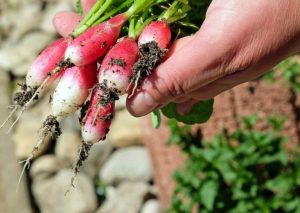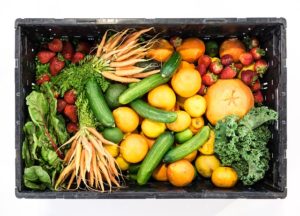When I think about climate change, I sometimes feel helpless in knowing how to do more. I don’t drive very much, recycle, compost kitchen scraps, grow some of my own food and bring my own bags when I go to the store. But like many people, I want to live a more sustainable lifestyle, and one place to start is with food. There are a number of ways to consume food more responsibly and reduce food waste. If you’re looking for some ways to decrease your food footprint, here are some ideas:
1) Think about frozen food. About 30% of food is wasted globally, and since produce makes up the lion’s share of food waste, many people are rediscovering frozen foods as a way to reduce waste and spoilage. In addition, frozen foods actually retain their nutritional value longer and have a lower carbon footprint than fresh produce.
2) Grow some of your own food. My husband and I share a community garden plot with another couple, and it provides us all with produce such as tomatoes, peppers, onions, greens and root vegetables from June until early October. In fact, the garden yields so much food that we end up giving  some of it away. Whether you grow some greens in pots on your back deck or have a garden plot, there’s a certain satisfaction from having food you just picked for dinner. And it lowers your food footprint.
some of it away. Whether you grow some greens in pots on your back deck or have a garden plot, there’s a certain satisfaction from having food you just picked for dinner. And it lowers your food footprint.
3) Stock up on healthy non-perishable foods as a way to cut food waste. Some good examples are dried beans, dried fruits and vegetables, nuts and seeds. They don’t need refrigeration and don’t contribute to food waste.
4) Try to buy organic food when possible. Organic foods are grown without the use of pesticides, which reduces the amount of chemical runoff that’s making its way into our streams and rivers. In addition, produce that’s grown organically allows for a larger variety of crops to be grown, biodiversity and improved soil quality–all of which translates into a more nutritious and sustainable source of food.
5) Get familiar with upcycled foods. These are reinvented foods that are made from the leftovers from other food processes. For example, unused juice pulp that goes into making granola bars, vegetable stems that have become chips and soup stock that’s made from vegetable scraps are all repurposed upcycled foods. For more information on upcycled food, check out the Upcycled Food Association at https://www.upcycledfood.org/ .
6) Compost. Composting is a way of decomposing kitchen scraps and yard waste into nutrient-rich fertilizer. However, when these items end up in a landfill to decompose, they produce greenhouse gas emissions because they decompose anaerobically—without oxygen being present. Think about this: according to the US Composting Council, if everyone in the United States composted their kitchen scraps, it would have the same effect as taking 7.8 million cars off the road. You can compost your kitchen scraps by mixing it with a little soil in a small corner of your back yard or in a bin specifically for composting. Also, some cities have a community composting program in which they offer weekly pick-ups of kitchen scraps and make the finished compost available to gardeners.
7) Look at how your food is packaged and stored. Opt for food products that come in recyclable or compostable containers. Some grocery stores are now using compostable “plastic” bags in their produce department. If the store where you shop doesn’t, request that they switch. At home, store your food in glass or metal containers, reusable storage wraps and cloth vegetable bags. The ultimate goal is to get plastic out of the picture.
8) Shop at your local farmer’s market. By doing so, you’re supporting smaller farmers in your area and eating seasonal and local produce. Also, a high proportion of the produce found at the farmer’s market is organic.
9) Purchase a CSA. CSA stands for community supported agriculture, and usually involves purchasing a weekly box of produce during the growing  season that’s grown by a local farmer. Each week you’ll receive a share of what’s in season, with some boxes being delivered to you and others that you have to pick up at a prearranged location. CSA farm shares are a great idea because they support local agriculture, provide you a way to eat seasonally and locally, and introduce you to produce that you may never have considered eating. Don’t think you can eat all that produce? It’s common for two households to split a CSA, and some farmers will offer half or quarter shares each week.
season that’s grown by a local farmer. Each week you’ll receive a share of what’s in season, with some boxes being delivered to you and others that you have to pick up at a prearranged location. CSA farm shares are a great idea because they support local agriculture, provide you a way to eat seasonally and locally, and introduce you to produce that you may never have considered eating. Don’t think you can eat all that produce? It’s common for two households to split a CSA, and some farmers will offer half or quarter shares each week.
10) Learn about gleaning. Gleaning is a historical practice of collecting leftover crops after a field has been harvested. Today however, the definition of gleaning has been expanded. People who have fruit trees in their yard may open it up to gleaning, farmers may offer gleaning in exchange for help in harvesting a crop or community gardeners may offer their excess produce to organizations that serve the food insecure. If you’ve always wished that someone could make use of all those apples on the tree in your front yard, gleaning may be the answer! For more information on gleaning, check out the National Gleaning Project at https://nationalgleaningproject.org/
The bottom line is that if you want to help combat climate change, you can do it through how you food shop and eat. There are several simple ways that you can reduce food waste and be a more responsible consumer. And the good news is that it’s a win-win situation. While you’re reducing your carbon footprint, you’re also increasing your own health and that of the planet.



